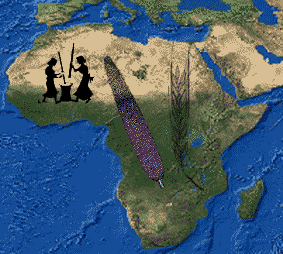|
IWAA
5
Themes
Registration
Previous
conferences
Institute
of
Archaeology
Accommodation
Getting
Here
Schedule
Publication |
|
Monday, 3 July, 2006
Session: Gathered resources: foragers, wood fuels and the environmental impac
THE FIRST VILLAGES OF CENTRAL AFRICA : ARCHAEOLOGICAL EVIDENCE OF LONG-DISTANCE CONTACTS, EARLY LAND-USE AND THE COLONISATION
OF VARIOUS ECOSYSTEMS BEFORE 2500 BP
Bernard CLIST
UR92 , Institut de Recherches pour le Développement, Orléans, France
Around 2500 BP, villages are known in south Cameroon (Obobogo Tradition and Kribi area coastal sites), in Gabon (Okala Tradition), in R.D. Congo (Imbonga Tradition), and in Congo north of Pointe Noire (Tchissanga Ware or Tradition). It is still not possible to link the Bioko Island archaeological sequence (Equatorial Guinea) to the mainland Traditions before c.2000 BP. Later, the Village Mode of Production will at a slower pace be known in the wooded savannas of northern Angola and Bas-Congo.
This Rain-Forest Tradition is strongly suggestive of the irregular movement of a new food-producing people from South Cameroon towards Congo and Angola, some groups following the complex coastal ecosystems of the Atlantic Ocean shores. It has been proposed to link this expansion to a slow evolution of Late Stone Age people in the Cameroon Grassfields and Nigeria area, from c.7000 BP onwards, to which later, following palaeoclimatic dry episodes, Neolithic peoples migrating from the Sahel and the Sahara added food production and pottery. This then gave way after some generations to the Rain-Forest Tradition c.3500 BP, and following a continuous population build up to a social stress mediated through migration to lands already surveyed. It can be shown the first inhabitants of the Obobogo Tradition settled in the forest before 3000 BP; it is later, between c.3000-2000 BP, that a strong dry climatic episode drastically reduced the rain-forest vegetation of Central Africa.
Between 3000 and 2500 BP villagers used a mixed economy : hunting, fishing, small stock raising (goats and sheep), farming (Pennisetum sp), arboriculture (Musa sp., Elaeis guineensis), wild fruit tree exploitation (Coula edulis, Canarium schweinfurthii). Recent excavations in Cameroon by german archaeologists have confirmed some of these results (see other contributions by Stefanie Kahlheber and Alexa Hohn). The study of the Okala Tradition in Gabon showed villages settled in a rather systematic way lands where farming and hunting/fishing could both be carried out. This is also suggestive of the use of rivers and the Atlantic Ocean for communication between communities. A complex network of long-distance contacts has been found following detailed typological analysis of the excavated material. While the use of millet and small stock raising hints to some kind of contact before 3000 BP with the Sahel hundreds of kilometres to the North-West, the banana (probably plantain) is indicative of contacts with East Africa before 2600 BP. On a smaller scale, stone resources were imported from as far away as 80 kilometres from villages (pestles, grounding tools, …), seashells collected on the beaches are found 200 kilometres to the East at Nkang; the close co-evolution and typological relationships between the Obobogo and Okala Traditions show the probable kinship ties maintained along some 300 kilometres after the migration of the first groups of people. Short term exotic contacts are evidenced by the discovery of a typical Okala Tradition pottery dated to c.2300 BP decorated with some kind of flexible roulette, while several generations later c.2100 BP a wooden roulette pottery was thrown away in a pit of an Obobogo Tradition site; both examples are evidence of short term contacts with villages using roulettes to the North of the Sanaga River, i.e. several hundreds of kilometres away.
Some kind of interaction must have been in full swing with the hunter-gatherer batwa people. Sadly evidence about this major anthropological issue is lacking : we can only say the arrival of the first villagers gives an idea of the 2000 years long and still ongoing interaction between food-producing communities and hunter-gatherers of Central Africa’s rain-forests.
...
return to Monday schedule
Tuesday 4 July . . . Wednesday, 5 July, 2006 .......
|


